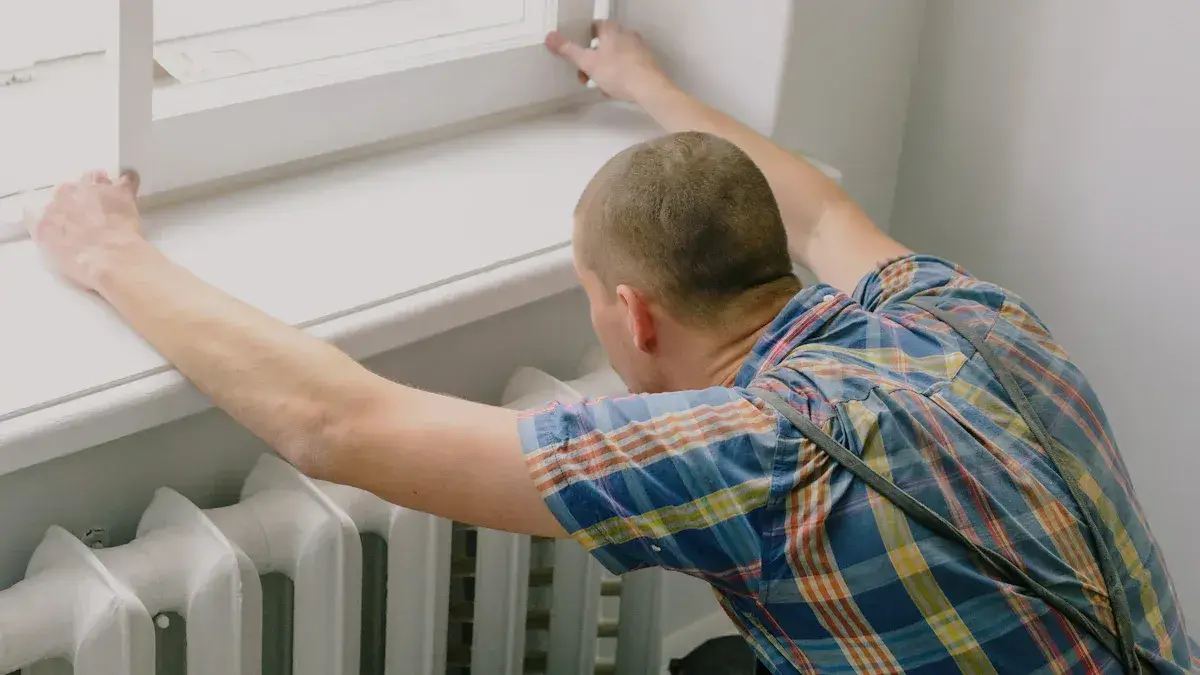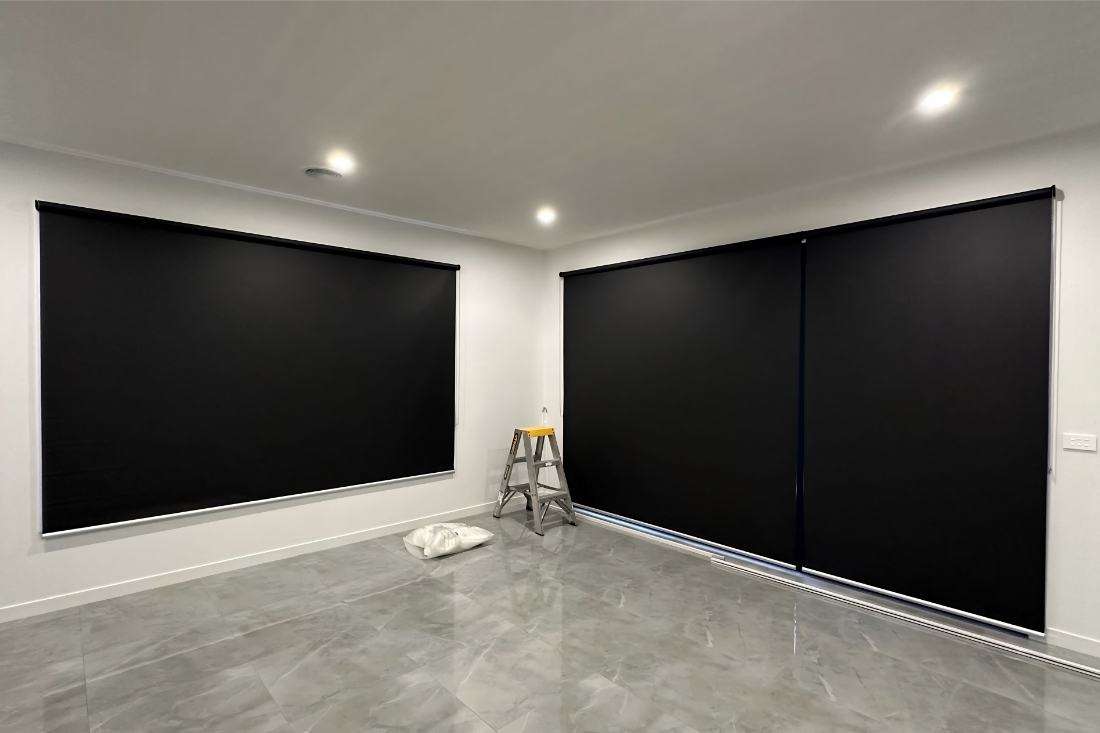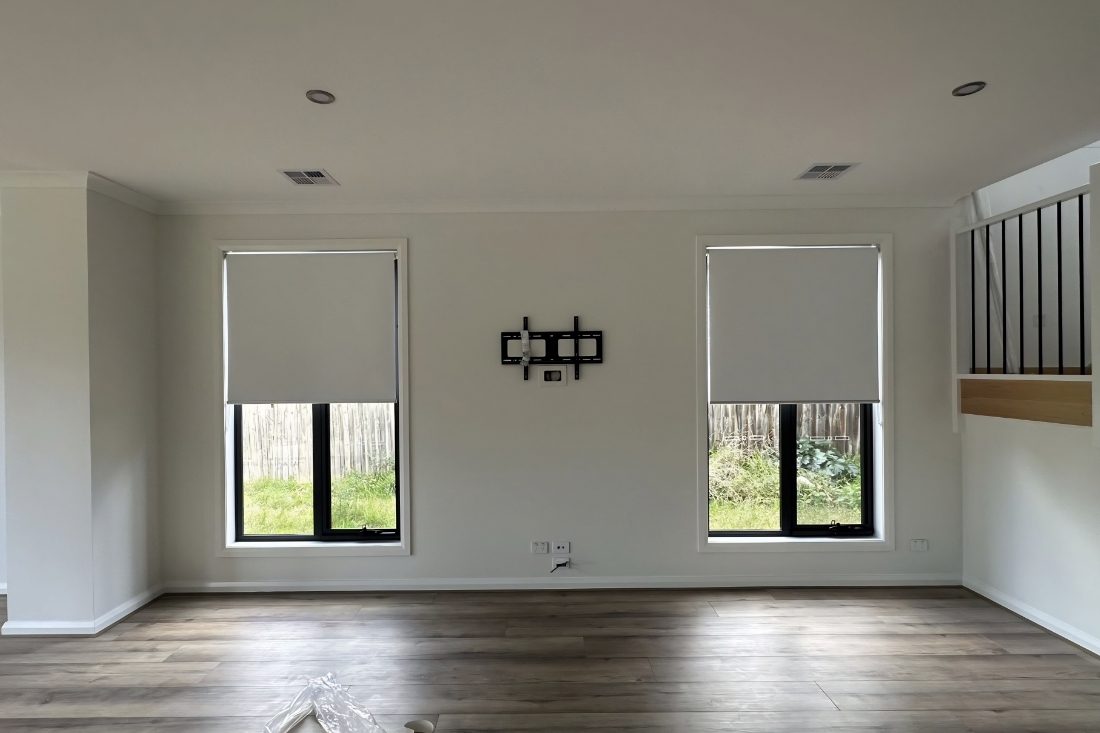No products in the cart.

Transform your home by learning to put up vertical blinds with ease. You’ll enhance your space’s appearance and gain excellent control over light. Additionally, it provides you with increased privacy. A study revealed that individuals felt happier and more confident after fitting blinds themselves, highlighting the benefits of undertaking the task independently.
Key Takeaways
- Collect tools like a tape measure, drill, and level first. Being ready helps make the job faster and simpler.
- Exact measurements are very important. Measure your window or door properly so the blinds fit well and you don’t get the wrong size.
- Pick inside or outside mounts depending on your window type and how much light you want to block. Inside mounts look neat, while outside mounts cover more space.
Tools and Materials Needed to Install Vertical Blinds

Before starting, gather all the tools and materials you need. Being prepared will make the job easier and faster.
Essential Tools
You’ll need some basic tools, which you might already have:
- Measuring Tape – Measure your window or door for the right size.
- Pencil – Mark where the brackets for the blinds will go.
- Drill and Drill Bits – Make holes for screws to attach the brackets.
- Screwdriver – Use it to tighten screws firmly into place.
- Spirit Level – Check that the brackets and headrail are straight.
- Step Ladder – Safely reach higher spots during the installation.
These tools are necessary whether you’re doing an inside or outside mount. For instance, the spirit level helps keep the blinds even, so the slats hang properly.
Optional Tools for Convenience
These extra tools aren’t required but can make things simpler:
- Key Hole Punch – Makes holes in fabric vanes if adjustments are needed.
- Vertical Slat Hooks – Useful for fixing or replacing slats easily.
- Wood Stain Markers – Cover up small scratches on wooden parts.
- Double Face Adhesive Tape – Temporarily holds brackets in place for alignment.
- Vertical Vane Repair Clips – Fix broken slats without needing replacements.
Tip: If this is your first time installing vertical blinds, use a dispenser for rolled goods to keep everything tidy.
Having these tools ready will save you time and prevent delays. Most installations take about 20–25 minutes if you’re well-prepared.
Getting Ready to Install Vertical Blinds
Getting ready is key for a smooth installation. Follow these steps to make sure your vertical blinds fit well and work properly.
Measuring Your Window or Door
Taking correct measurements is very important. Gather a pencil, paper, steel measuring tape, and a step ladder. Then, follow these steps:
- Measure the width of your window or door. For inside mounts, measure from one frame side to the other. For outside mounts, measure the area you want to cover. Add at least four inches on each side to block light gaps.
- Write down the width to the nearest quarter inch.
- Measure the height. For inside mounts, measure vertically in three spots: left, middle, and right. Use the shortest measurement to ensure a good fit. For outside mounts, measure from the sill to three inches above the window top.
- Record the height to the nearest quarter inch.
- Repeat these steps for every window or door where you’ll install blinds.
| Measurement Type | Details |
|---|---|
| Depth of Window Frame | Measure from the front edge to the glass. |
| Width of Window Opening | Record the width at the top of the opening. |
| Height of Window Opening | Measure in three spots and use the shortest one. |
| Extra Width for Outside Mount | Add at least four inches on both sides to block light gaps. |
| Height for Outside Mount | Measure from the sill to three inches above the window top. |
Tip: Always double-check your measurements. This avoids ordering blinds that don’t fit. Accurate measuring saves time and effort later.
Picking Inside or Outside Mounts
Choosing between inside or outside mounts depends on your window and style preference. Inside mounts look neat and simple, while outside mounts block more light and hide window flaws.
| Criteria | Inside Mount Blinds | Outside Mount Blinds |
|---|---|---|
| Installation Difficulty | Harder; needs exact alignment and depth. | Easier; just measure width and height. |
| Light Control | May let light in; not great for dark rooms. | Blocks more light; gives better privacy. |
| Aesthetic Impact | Looks clean and simple; may show window flaws. | Hides flaws; adds a decorative touch. |
| Window Compatibility | Needs at least 2.5 inches of depth; not for shallow windows. | Works with any window size or shape; good for shallow windows. |
| Noise and Draft Reduction | Less effective; doesn’t seal well. | Better; covers the whole window for insulation. |
| Cost Considerations | Cheaper; uses fewer materials. | May cost more; needs extra hardware or fabric. |
To decide the best option for your space:
- Measure your window frame’s depth. Inside mounts need at least 2.5 inches.
- Look for obstructions like handles or cranks that might get in the way.
- If your window is shallow or has obstructions, choose an outside mount.
Marking Where Brackets Go
After choosing the mount type, mark where the brackets will go. This ensures the blinds hang straight and work well.
- Attach the brackets to the headrail. Hold the headrail against the wall or frame to see where the brackets should go.
- Use a pencil to mark screw spots on the wall or frame.
- Do the same for the other brackets, keeping them evenly spaced.
- Check with a spirit level to make sure the brackets are straight. Straight brackets stop the blinds from tilting or breaking.
Note: For outside mounts, place the brackets high enough to fully cover the window opening.
By measuring carefully, picking the right mount, and marking bracket spots correctly, you’ll be ready for a successful installation.
How to Install the Brackets
Putting up the brackets is an important step. It ensures your vertical blinds work well. Whether you pick an inside or outside mount, doing it right gives a strong and neat finish.
Inside Mount Installation
Inside mounts fit the blinds inside the window frame. They give a simple and tidy look. Follow these steps to install the brackets:
- Position the Headrail: Hold the headrail inside the frame. Make sure it is straight and centred.
- Mark Bracket Spots: Use a pencil to mark where the brackets will go. Place them at least 2 inches from each end of the headrail.
- Drill Small Holes: Drill small holes at the marked spots. This helps screws go in easily and stops wood from cracking.
- Fix the Brackets: Attach the brackets to the frame with screws. If the frame is plaster or drywall, use wall anchors for extra strength.
- Check Straightness: Use a spirit level to check if the brackets are straight. Crooked brackets can make the blinds hang unevenly.
Tip: If holding the headrail and marking spots is tricky, ask someone to help. This makes it easier and avoids mistakes.
Outside Mount Installation
Outside mounts cover bigger areas and hide window flaws. They also block more light. Here’s how to install brackets for an outside mount:
- Decide Placement: Hold the headrail above the window frame. Make sure it covers the area you want. Mark the top edge with a pencil.
- Mark Bracket Positions: Place the brackets on each side of the headrail. Keep them at least 2 inches from the ends. Mark the screw holes on the wall.
- Drill Pilot Holes: Drill small holes at the marked spots. Use wall anchors for plaster or drywall to keep the brackets secure.
- Attach the Brackets: Fix the brackets to the wall with screws. Check they are straight using a spirit level.
- Snap in the Headrail: Once the brackets are fixed, snap the headrail into them. Make sure it clicks firmly to avoid wobbling.
Note: For outside mounts, place the brackets high enough. This ensures the blinds fully cover the window for better privacy and light control.
Extra Tips for Success
- Always check your measurements and alignment before drilling. This avoids extra holes and keeps the installation neat.
- If you’re putting up several blinds, finish one set of brackets at a time for consistency.
- Try using augmented reality (AR) guides if available. AR tools can help you install more accurately and confidently.
By following these steps, your vertical blinds will be securely mounted and ready for the next step.
Attaching the Headrail
Securing the Headrail
Securing the headrail is a crucial step in installing vertical blinds. It ensures the blinds function smoothly and stay in place. Follow these steps to attach the track securely:
- Position the blinds a few inches above the window. Ensure the headrail aligns with the window opening.
- Use a spirit level to draw a straight line where the top of the headrail will sit. This helps keep the track even.
- Mark the positions for the mounting brackets evenly along the line. Use a pencil to mark the screw holes for accuracy.
- Drill small pilot holes at the marked spots. This makes it easier to screw in the brackets and prevents damage to the wall.
- If you are mounting on drywall, insert wall anchors into the pilot holes. These provide extra support for the brackets.
- Secure the mounting brackets using the screws provided in your kit. Tighten them firmly to ensure stability.
- Lift the headrail into place and click it into the brackets. You should hear a snapping sound, confirming it is securely attached.
Tip: Double-check that the headrail is level before moving to the next step. A crooked track can cause the slats to hang unevenly.
Aligning the Headrail Properly
Proper alignment of the headrail ensures the blinds operate smoothly and look professional. After you attach the track, take a moment to check its position.
- Stand back and visually inspect the headrail. Ensure it is parallel to the window frame or wall.
- Use a spirit level to confirm the alignment. Place it along the length of the headrail. Adjust the brackets if necessary to correct any tilt.
- Test the headrail by gently sliding it back and forth. It should move smoothly without resistance. If it feels stuck, check the brackets for misalignment.
Note: Proper alignment not only improves functionality but also enhances the overall appearance of your vertical blinds.
By following these steps, you can install the headrail securely and ensure it is perfectly aligned. This sets the foundation for hanging the slats and completing your project.
Hanging the Slats or Vanes

Connecting the Slats to the Headrail
After securing the headrail, it’s time to attach the slats. Follow these simple steps to do it correctly:
- Find the Stem Carriers: These are the small hooks on the headrail. They hold the slats. Make sure they are spaced evenly.
- Check the Slats: Lay the slats flat and look for any damage. If damaged, use repair kits to fix or replace them.
- Attach Each Slat: Hold a slat at the top. Push it gently into the stem carrier until it clicks. Do this for all slats, ensuring they face the same way.
- Test the Connection: Pull each slat lightly to check it is secure.
Tip: If slats don’t align well, use painter’s tape to hold them temporarily. This helps them move smoothly later.
For extra help, check guides like Adjust Rotation Chain or Attach 1 Touch Wand to Stem.
Adjusting the Slats for a Uniform Look
Once the slats are attached, adjust them for a neat finish. Proper alignment makes the blinds work better and look tidy.
- Check the Gaps: Step back and look at the slats. They should hang straight without gaps or overlaps. Adjust the hooks if needed.
- Level the Bottoms: Make sure the bottom edges of the slats are even. If not, gently pull them to fix their position.
- Test Movement: Use the control chain or wand to rotate the slats. They should turn easily. If they stick, check troubleshooting guides like Louvers Will Not or Hard to Traverse.
Note: Aligning the slats improves how they look and work. A tidy finish makes your blinds look professionally installed.
By following these steps, you’ll attach the slats securely and ensure they hang evenly. This completes an important part of installing vertical blinds.
Installing Safety Devices for Vertical Blinds
Keeping your vertical blinds safe is very important. This is especially true if you have kids or pets. Adding safety devices lowers risks and meets safety rules.
Types of Safety Devices
Safety tools stop accidents caused by hanging cords. Here are some common ones:
- Cord Cleats: Small hooks to wrap extra cord neatly. This keeps cords out of children’s reach.
- Cord Tensioners: These hold cords tightly to walls or frames. They stop cords from forming loops.
- Breakaway Connectors: These snap apart under pressure. This helps prevent strangulation.
- Cordless Systems: These remove cords completely. They are the safest choice for homes with small children.
The ANSI/WCMA A100.1-2022 standard stresses the need for safety tools. It aims to remove dangers from cords, which can harm children.
Also, look for seals like the Parents for Window Blind Safety Seal or WCMA Best for Kids certificate when picking safety tools.
Steps to Install Safety Devices
Follow these steps to fit a child safety device properly:
- Place the Cord Cleat or Tensioner: Fix it at least 1600mm above the floor. This keeps it out of children’s reach.
- Mark Screw Spots: Use a pencil to mark where screws will go. Make sure the device is straight.
- Drill Small Holes: Drill tiny holes where you marked. This makes attaching the device easier.
- Fix the Device: Use screws to attach the cleat or tensioner securely. Don’t tighten too much.
- Secure the Cord: Wrap the cord around the cleat or thread it through the tensioner. Make sure loops are no longer than 220mm.
Tip: Test the device after fitting it. Check that it holds the cord firmly and works smoothly.
By following these steps, you can make your vertical blinds safe for everyone in your home.
Testing and Operating the Blinds
Checking the Cord and Chain Mechanism
After installing the blinds, test the cord and chain. Gently pull the cord to open and close the slats. Watch how the slats move. They should slide smoothly without sticking. If they jam, check the brackets and adjust them.
Blinds go through many tests to ensure safety and durability. UV tests check if they resist sunlight damage. Cycle tests confirm they work after repeated use. Weight tests measure how much load the mechanism can handle. Torque tests ensure cords don’t create dangerous gaps. These tests make sure your blinds are safe and reliable.
Tip: Look at the cord and chain often for damage. Replace worn parts quickly to keep them safe and working well.
Trying the Wand Control
If your blinds have a wand, testing it is easy. Turn the wand to adjust the slats’ angle. They should turn evenly and line up straight. Slide the wand to open or close the blinds. The slats should move together without gaps. If they don’t, check the brackets for alignment.
Wand controls are safer than cords, especially for kids and pets. They prevent tangling and give better control over light and privacy. Clean the wand with a damp cloth sometimes. Don’t use too much force when using it.
By testing the cord, chain, or wand, you ensure the blinds work well. This final step finishes the installation, giving you stylish and functional blinds.
Putting up vertical blinds is easy if you follow steps. You’ll get a neat look and enjoy their usefulness and style. Many people say the installation is simple and the results are great.
| Source | Average Rating |
|---|---|
| Slats | 5.0 stars (from 7 reviews) |
- The Blind Lady Custom Blinds: Customers love the care given and recommend the service.
- World of Blinds and Shutters: Reviews mention top quality and helpful customer support.
- Skyline Window Coverings: People like the choices and expert installation offered.
Doing the job carefully makes sure it’s safe and works well. Your blinds will look stylish and function properly.
FAQ
How can you make sure the blinds hang straight?
Check the headrail with a spirit level. Adjust the brackets if needed to keep the blinds even.
Is it possible to put up blinds without drilling?
Yes, you can use adhesive or tension mounts. But drilling is stronger, especially for heavy blinds or regular use.
What if the slats won’t turn properly?
Look at the stem carriers for blockages. Make sure the headrail is straight. If it still doesn’t work, check the manufacturer’s instructions for help.










Leave a Reply